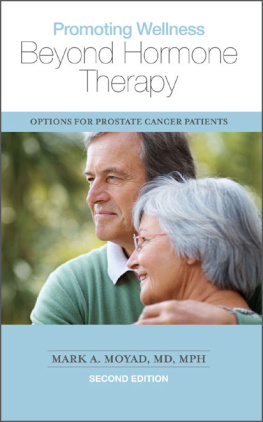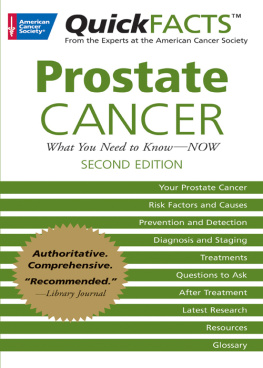FOURTH EDITION
Promoting
Wellness
for Prostate Cancer Patients
A GUIDE FOR MEN AND THEIR FAMILIES
Mark A. Moyad, MD, MPH

Copyright 2013 Mark A. Moyad
All rights reserved under International and Pan American Copyright Conventions.
No part of this book may be reproduced or transmitted in any form or by any means electronic or mechanical including photocopying, recording, or by any information storage and retrieval system, without permission in writing from the publisher.
This edition is published by Spry Publishing LLC
2500 South State Street
Ann Arbor, MI 48104 USA
10987654321
Library of Congress Cataloging-in-Publication Data on file.
E-book ISBN: 978-1-938170-07-2
Disclaimer: Spry Publishing LLC does not assume responsibility for the contents or opinions expressed herein. Although every precaution is taken to ensure that information is accurate as of the date of publication, differences of opinion exist. The opinions expressed herein are those of the author and do not necessarily reflect the views of the publisher. The information contained in this book is not intended to replace professional advisement of a patients doctor prior to beginning or changing the patients course of treatment.
This book is dedicated to my dad and doctor, Robert Moyad.
He taught me what it means to put patients first
and what it means to be a good husband and father.
It is also dedicated to my wife Mia,
who has been my best friend since the day we met.
To say I won the lottery when I met her is actually
an understatement.
And finally, this book is dedicated to the individualsEpstein,
Jenkins, Pokempner, and Thompsonwho invest in the dream
and allow me to make a difference one starfish at a time.
Contents
Welcome To The Fourth Edition of Promoting Wellness for Prostate Cancer Patients: A Guide for Men and Their Families. This book has been the most widely distributed prostate cancer book in the world for the last 10 years, and it has been translated into multiple languages. It deals with all aspects of prostate cancerfrom diet, dietary supplements, and other lifestyle recommendations, to prevention and treatment tips, to managing the common (and not so common) side effects of cancer treatment. Most of the information included in this book is the result of talking to patients, families, and healthcare professionals living and working in all corners of the world. From Alaska to Australia, from Europe to Singapore and South Africa, I find in my travels that we are all spiritually united and so similar in countless ways, including our desire to eliminate cancer from the face of the earth and to have access to the best possible information and care. Therefore, the goal of this fourth edition is the same as all previous onesto empower you with information and lifestyle suggestions needed to assist you in communicating with your doctor and other healthcare professionals while dealing with prostate cancer. All of the chapters have been updated and expanded and there are added tips, novel reminders, and research to continue to help you increase the chance that you can live a long and overall healthy and happy life. With all of the exciting research underway, I look forward to the day that my book will be placed in a medical museum and no longer needed by a single man. In the meantime, I hope this book and the global movement that is Promoting Wellness meet all of your expectations.
All my best,
Mark A. Moyad, MD, MPH
Jenkins/Pokempner Director of
Preventive & Alternative Medicine
University of Michigan Medical Center
Department of Urology
Ann Arbor, Michigan
Email:
Promoting
Overall Wellness
When you receive a cancer diagnosis, it may be tempting to focus your wellness activities on the affected area of your body, but there is a basic fact that Id like you to considercardiovascular disease (CVD) is the number one cause of death in men (actually, the leading cause of death for women, too!). Let me repeat this important factCVD is the number one cause of death in menand that includes men diagnosed and treated with prostate cancer!
Prostate cancer treatments are so successful today that, after most men are treated, their risk of dying of prostate cancer becomes somewhat similar to the average mans without prostate cancer risk. So, what is the point of being treated for prostate cancer and not working to reduce your risk of heart disease? In addition, there is now plenty of clinical research to suggest that being heart healthy after being diagnosed with prostate cancer may actually increase the chances of beating prostate cancer itself! Therefore, as we start this section on overall wellness, we will look at some ways that you can reduce your risk of developing heart disease and possibly improve prostate health as well.
Cardiac Health
Know Your Numbers
As we start to explore heart health, we will consider some measurements used to gauge how your body is responding to your lifestyle choices. In the same way that a PSA number or prostate exam provides an initial assessment of your prostate health, knowing your cholesterol and blood pressure numbers can give you a first overview of your cardiac health. A bonus to having your cholesterol regularly measured is that it is a good indicator of how well any lifestyle changes you make are working. In recent dietary studies of individuals with prostate cancer, the individuals who followed the healthiest lifestyle programs also had some of the largest reductions in cholesterol.
So, lets explore what a cholesterol test involves. The blood test is usually done after fasting for 9 to 12 hours and it measures four thingstotal cholesterol, LDL (bad cholesterol), HDL (good cholesterol), and triglycerides (a type of fat found in your blood). Those items are worth some definition to help you understand their importance.
Total Cholesterol: An overview number developed with a formula applied to LDL, HDL, and triglyceride components. Lower numbers are better unless your HDL is really high.
Low-Density Lipoproteins (LDL): Also called bad cholesterol, LDL can cause buildup of plaque on the walls of arteries. The more LDL there is in the blood, the greater the risk of heart disease.
High-Density Lipoproteins (HDL): Also called good cholesterol, HDL helps the body get rid of bad cholesterol in the blood. The higher the level of HDL cholesterol, the better. If your levels of HDL are low, your risk of heart disease increases.
Triglycerides: Triglycerides are a type of fat that is carried in the blood. Lower numbers are better.
Cholesterol numbers are measured in mg/dL (milligrams per deciliter) in the United States and mmol/L (millimoles per liter) in other countries. The following table provides information on understanding your cholesterol scores.
| Total Cholesterol |
| Less than 160 mg/dL (Less than 4.14 mmol/L) | Optimal |
| 160-200 mg/dL (4.145.16 mmol/L) | Desirable |
| 201-239 mg/dL (5.176.19 mmol/L) | Borderline high |
| 240 mg/dL or higher (6.20 mmol/L or higher) | High |
| LDL (bad cholesterol) |
| Less than 70 mg/dL (Less than 1.81 mmol/L) | Ideal for high risk |
| Less than 100 mg/dL (Less than 2.59 mmol/L) | Optimal |
| 100-129 mg/dL (2.593.34 mmol/L) | Nearly optimal |










